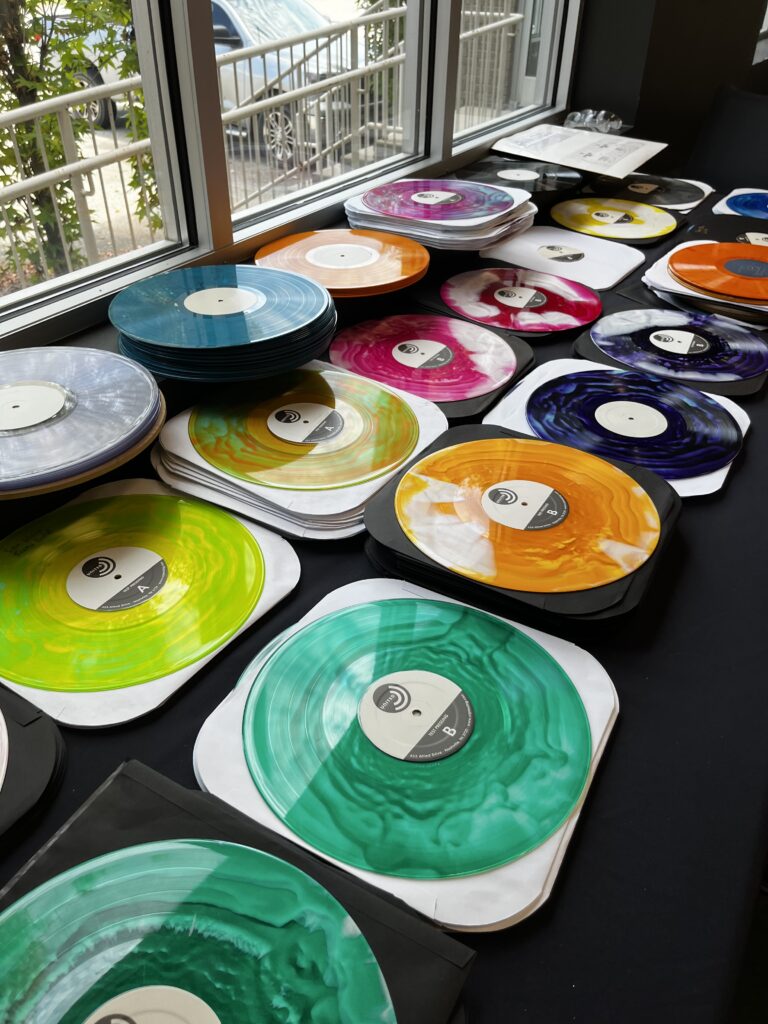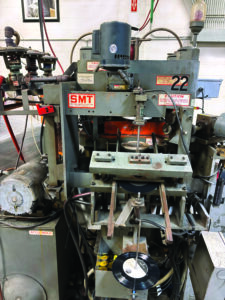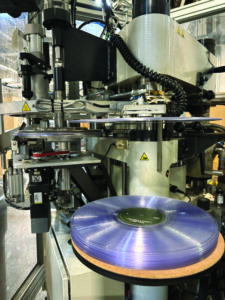
Vinyl records possess a depth and warmth many argue digital formats can’t replicate. But how does your favorite music get into that piece of plastic? Is it magic? Science? Or a little bit of both?
“It’s mostly just magic,” says Cam Sarrett, Director of Sales and Marketing at the Hogwarts of record pressing plants, United Record Pressing, in Nashville.
The United complex is made up of three buildings and takes up several blocks in an industrial area south of downtown. A lot has to happen in these buildings before a chunky, hockey puck-sized piece of plastic is hydraulically pressed between two round plates of metal to make a record — including a trip through a large room that looks like a science lab.
In this room, six long, narrow tubs — each about two feet wide and 12 feet long — are filled with a greenish, bubbling liquid. It’s here we find out that making records is not really magic at all; it’s chemistry.
“So you first have a lacquer, which is a positive. You get it silvered, and then you have a father (negative), mother (positive), stamper (negative), and record (positive). And there you go.” Sarrett explains.
The Vinyl Record Pressing Process
To get a clearer picture of the process, let’s start from the beginning. A band goes into a recording studio and creates music. A sound engineer mixes the tracks together. The final mix is then sent to a mastering engineer who uses sound production tools like compression and equalization to make sure the recording sounds good. They also create the digital file that gets sent over to a manufacturer like United Record Pressing. These digital files end up being cut into an aluminum disc called a lacquer.
“The lacquer is like a thin aluminum disc covered in a varnish that’s almost like nail polish,” Sarrett says. “The music is cut into that varnish, nail polish kind of thing with a lathe. But it’s just a machine with a needle that transfers the digital music into a physical signal cut into the lacquer.”
It’s these grooves, tiny and intricate, that carry the sound.
The delicate lacquer is much too fragile to use in a record press and must now go through a three-step electroplating process to create three additional physical copies – the father, the mother, and the stamper. Each step of the process creates a stronger version.
To prepare the lacquer for the first step, it’s sprayed with silver to make sure it’ll take in an electrical current during the nickel bath — which is what the green, bubbly liquid is. The solution in the nickel bath that adheres to the lacquer creates a negative copy — which has ridges instead of grooves — and is called the father. The father is peeled off the lacquer but is still too fragile and must be duplicated again.
“The mother is made off of the father and…these stampers are made off the mother,” Sarrett explains. “The mother is a positive piece of metal work…and you can do about ten stamper sets per mother. So, father, step one; mother, step two; stamper, step three. Three step plating. And so it’s incredibly important to get good stampers if you want good records.”
Once the stamper is created, it has to be prepped for use by the presses, the machines that actually make the vinyl records. United has two types of presses — newer, fully automated Pheenix presses and the ones we’re looking at now, the Lened presses.

Lened vs. Pheenix
“These are the machines that were made in the seventies in New Jersey, the workhorses. They’ve been retooled. They’ve been rebuilt. This is like your seventies Mercedes sedan of pressing machine,” says Sarrett.
 In another cavernous building are large white pipes running from the ceiling that connect to clean, white, trimmed, eight-feet-tall by five-feet-wide glass-enclosed pods. Inside each pod is a fully functional record press. If the Lened presses are the seventies Mercedes sedan, then these newly manufactured Pheenix machines are the Prius.
In another cavernous building are large white pipes running from the ceiling that connect to clean, white, trimmed, eight-feet-tall by five-feet-wide glass-enclosed pods. Inside each pod is a fully functional record press. If the Lened presses are the seventies Mercedes sedan, then these newly manufactured Pheenix machines are the Prius.
In each press are two stampers, one for side A and one for side B. A vinyl plastic pellet mix is loaded into the press through a hopper, which feeds it into an extruder. The extruder heats up the vinyl and shapes it into the pucks.
Sarrett continues, “The pucks go into the machine in between two stamper plates. The labels are sandwiched on the top side and bottom side of the puck. While it’s still warm, it is hydraulically pressed excess cutoff. And then you know you have a finished record.”
The United Record Pressing factory has a certain charm to it. Perhaps it’s knowing that there’s a place where people mix years of craftsmanship and passion into a vat of polyvinyl chloride pellets to make warm and rich-sounding art. Maybe that’s the magic.
This feature was originally part of a full episode of This Is Nashville: United Record Pressing celebrates 75 years


